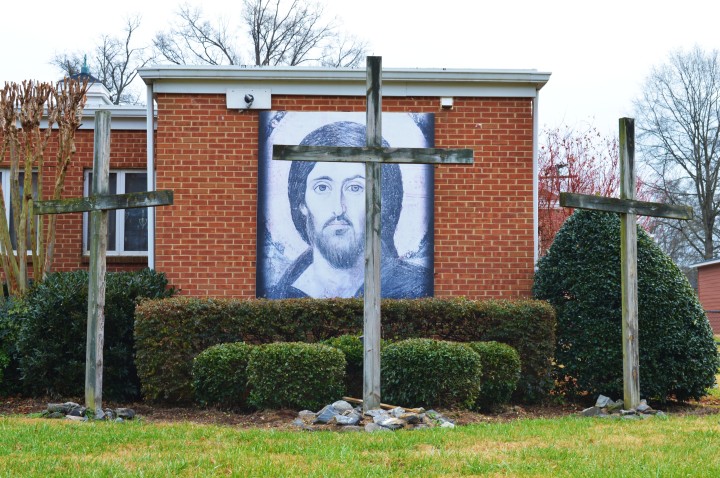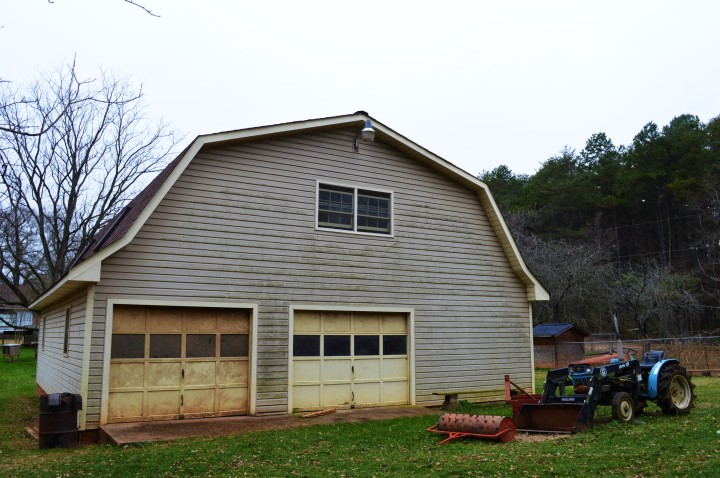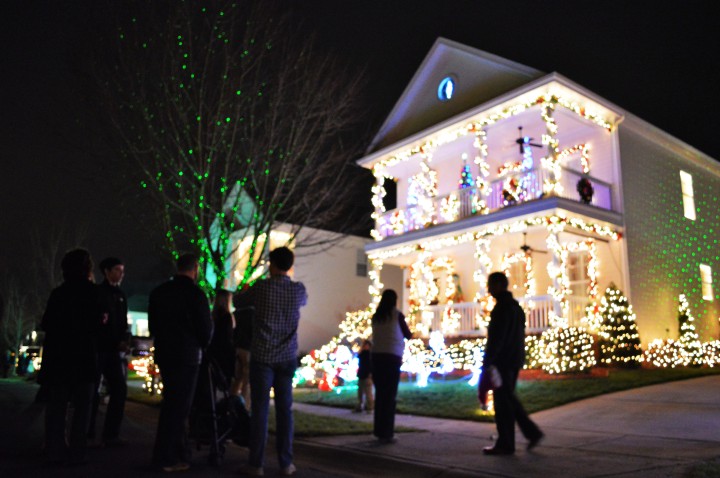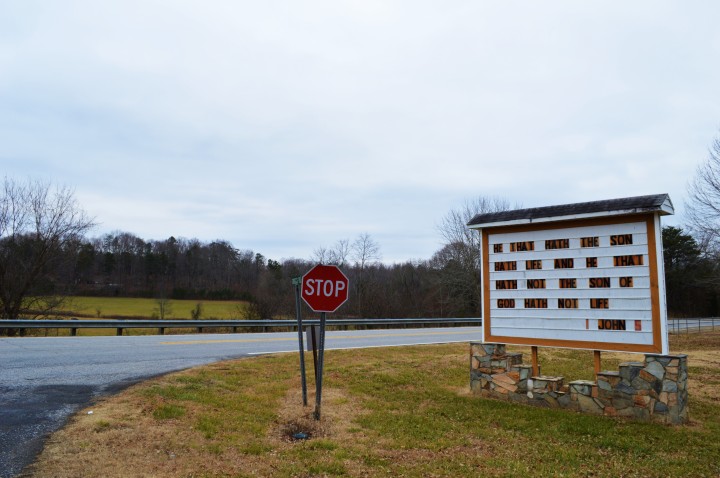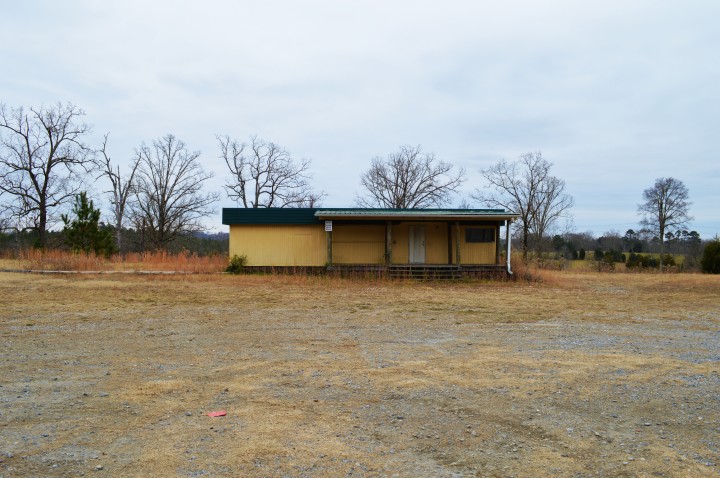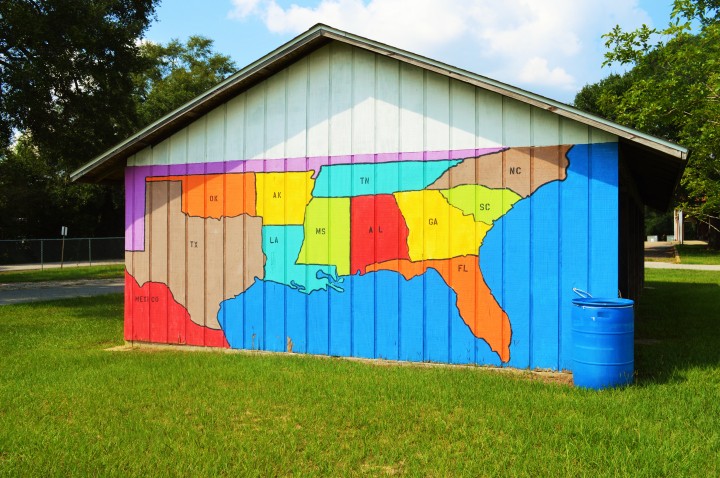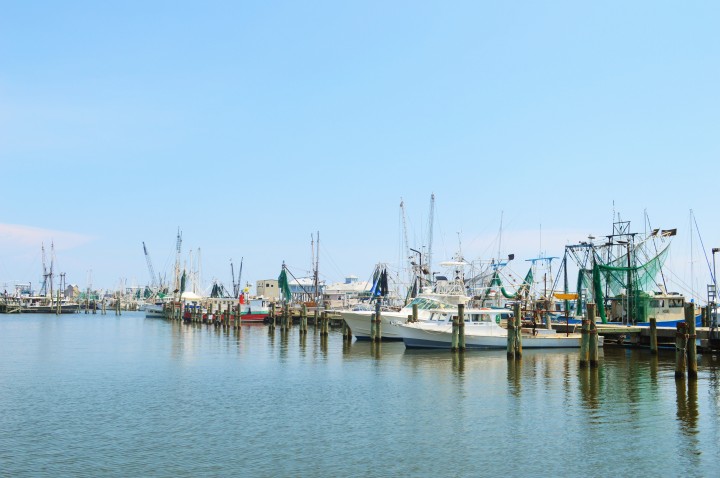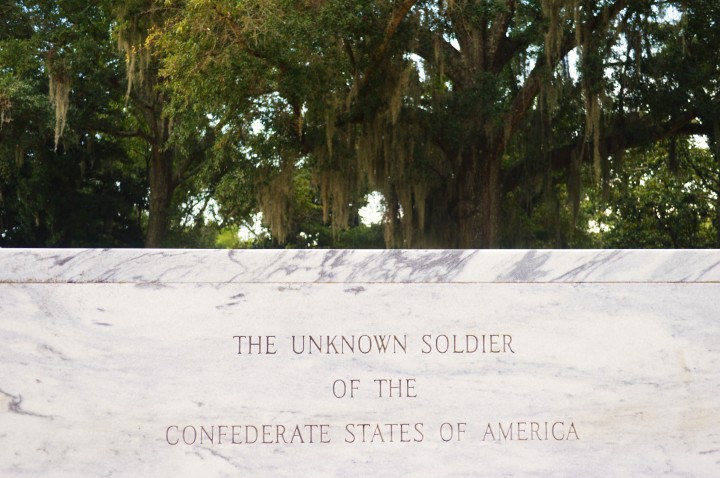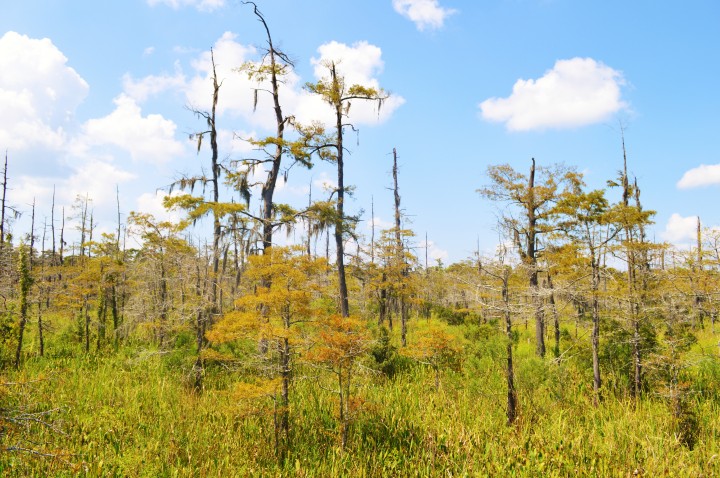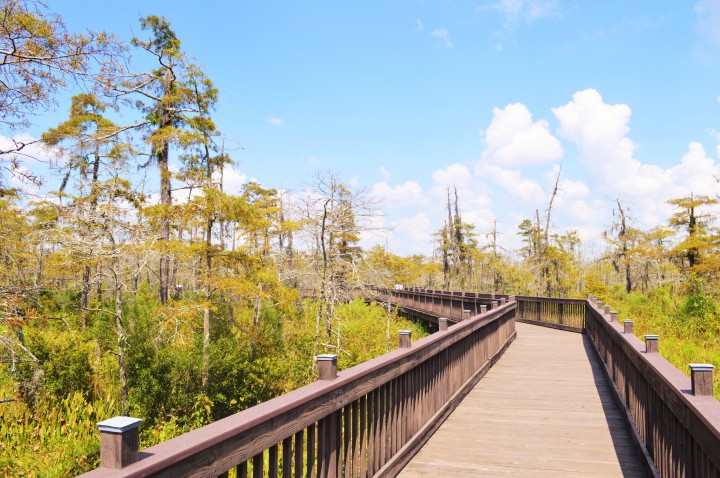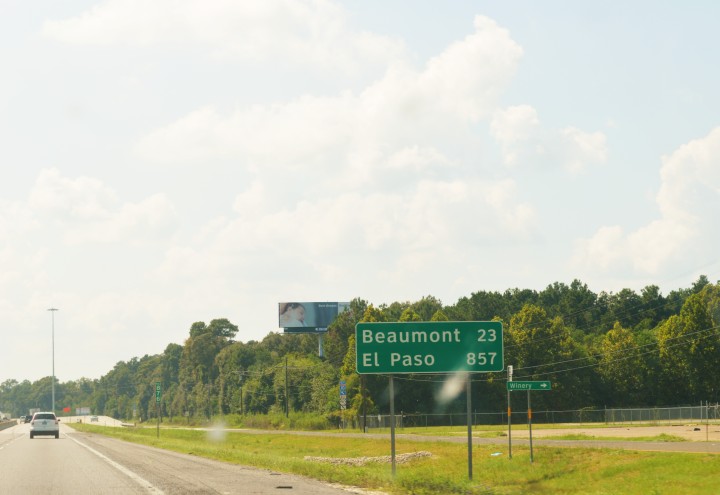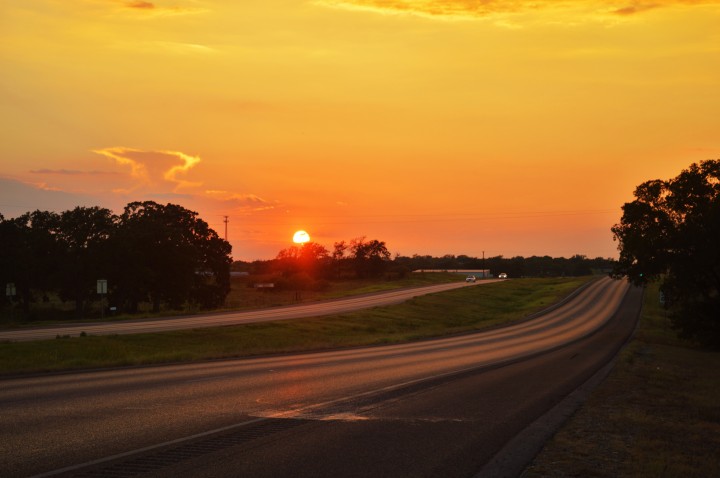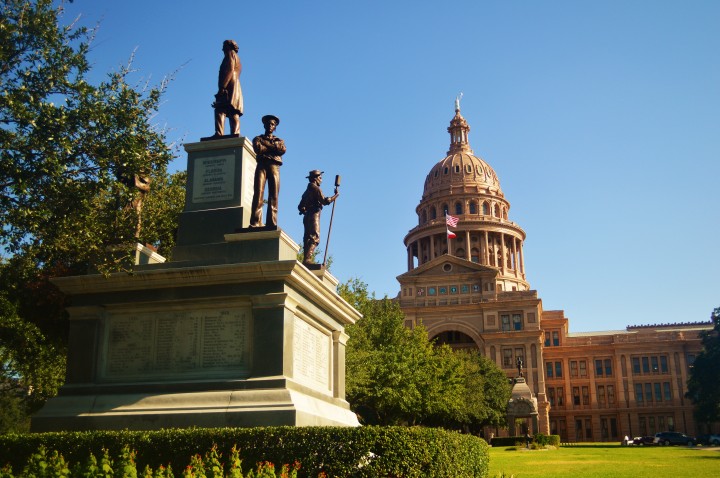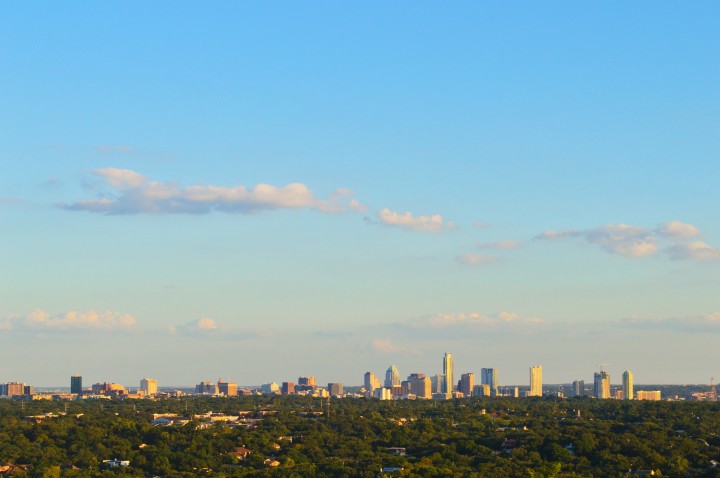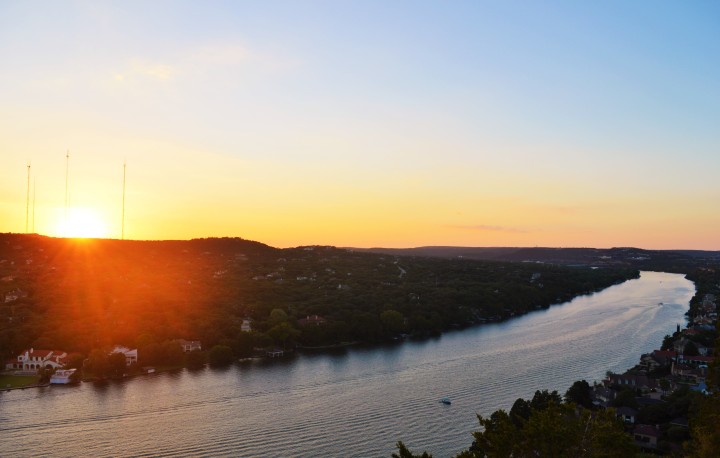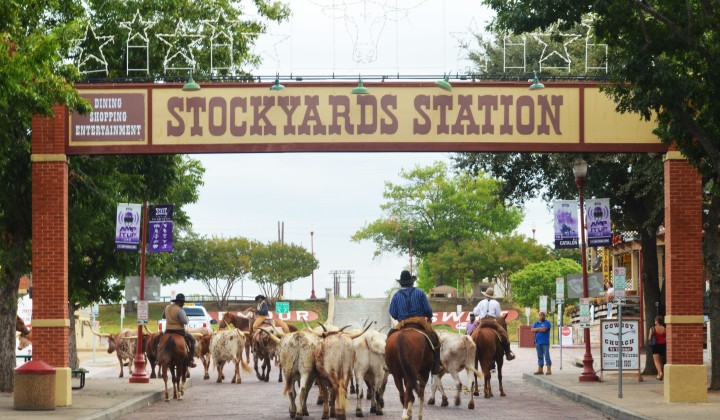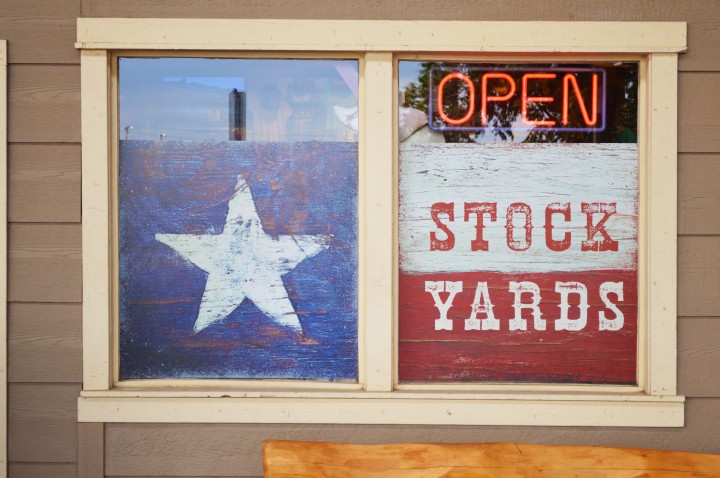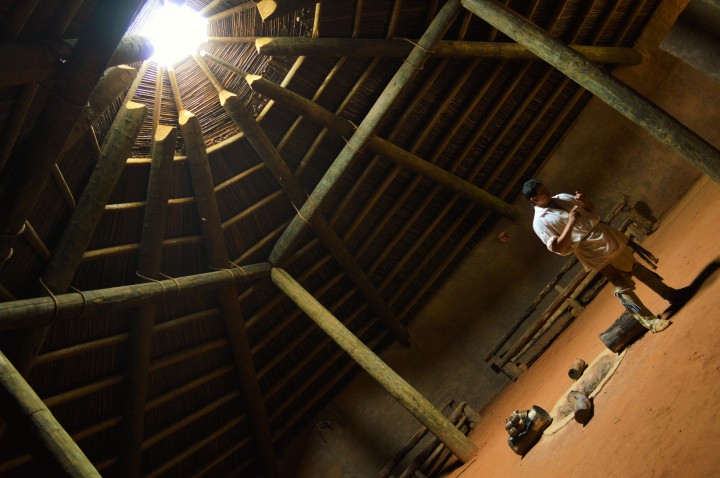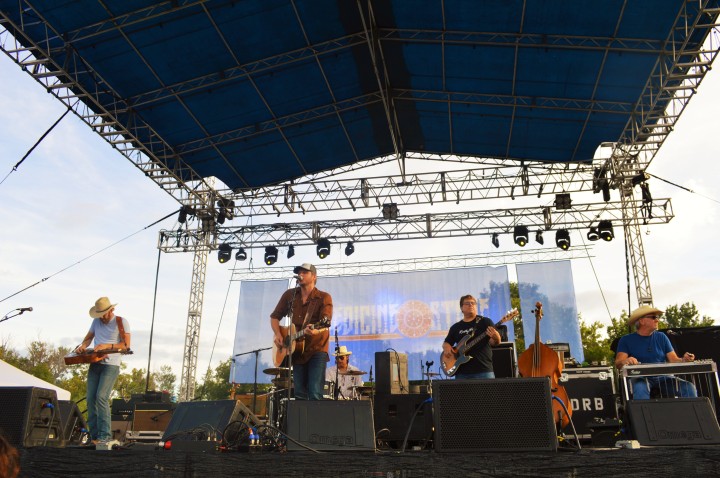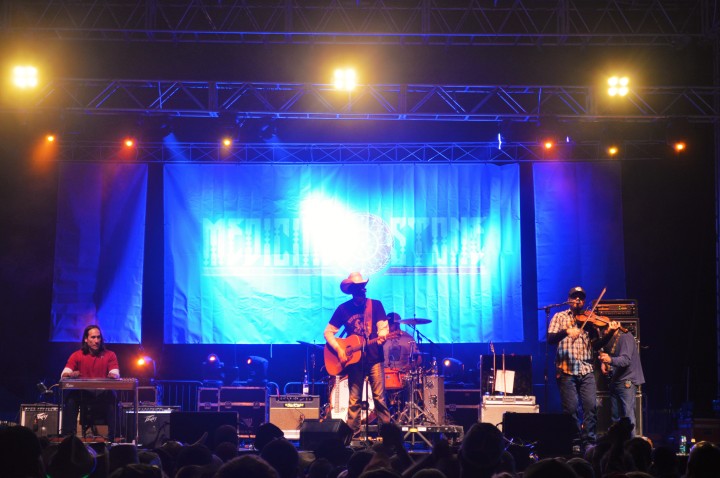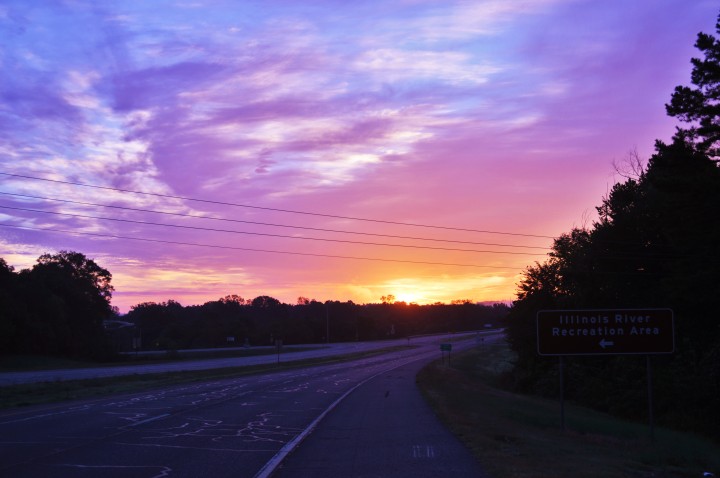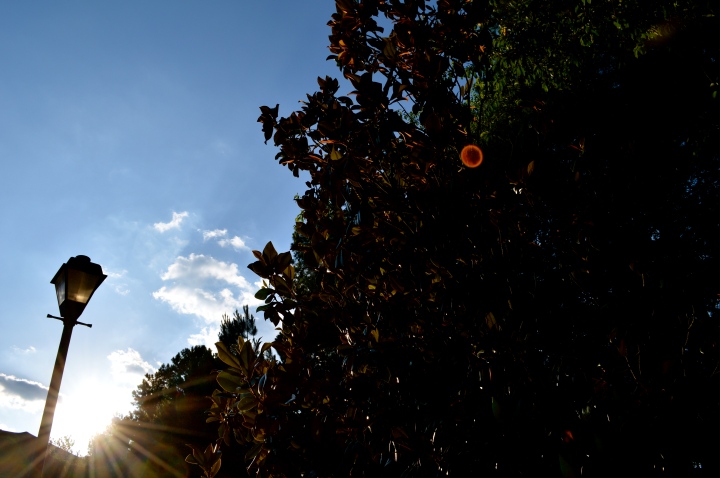 Late Afternoon. Decatur, Georgia. The days are still getting longer here in Atlanta and the pungent scent of magnolia blooms fill the humid air. I don’t know who first used the phrase “Hotlanta,” but it’s not likely that that person was a Southerner. Maybe they were from Michigan or Maine or Oregon, because summer here isn’t all that much hotter here than it is in Nashville or Charlotte or Montgomery. Or maybe the originator of the phrase was commenting on the people of this city and not the average temperature. I sure don’t know. (Words and photography by author. For more, subscribe here, or follow me on Instagram @highwayandhome)
Late Afternoon. Decatur, Georgia. The days are still getting longer here in Atlanta and the pungent scent of magnolia blooms fill the humid air. I don’t know who first used the phrase “Hotlanta,” but it’s not likely that that person was a Southerner. Maybe they were from Michigan or Maine or Oregon, because summer here isn’t all that much hotter here than it is in Nashville or Charlotte or Montgomery. Or maybe the originator of the phrase was commenting on the people of this city and not the average temperature. I sure don’t know. (Words and photography by author. For more, subscribe here, or follow me on Instagram @highwayandhome)
Train Car. Cowan, Tennessee.
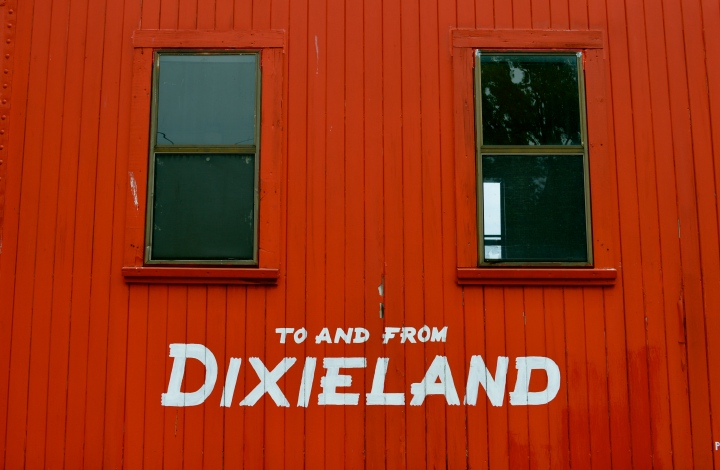 Train Car. Cowan, Tennessee. Situated along the Nashville, Chattanooga & St. Louis Railway, Cowan is the last stop before the climb up the Cumberland Plateau. Downtown, they’ve re-purposed the old depot, making it into a railroad museum. This is one of the cars on display. (Photo and words by author.)
Train Car. Cowan, Tennessee. Situated along the Nashville, Chattanooga & St. Louis Railway, Cowan is the last stop before the climb up the Cumberland Plateau. Downtown, they’ve re-purposed the old depot, making it into a railroad museum. This is one of the cars on display. (Photo and words by author.)
Howard Finster’s Paradise Garden: the Unpublished Photographs.
This morning, I published an article titled “Roadside oddities: Howard Finster’s Paradise Garden” on Examiner.com, which you can read by clicking here. Of the many photographs I took during my visit the Paradise Garden, only one could accompany the Examiner article. The purpose of this post is to share the rest of the photographs, the ones that remain unpublished.
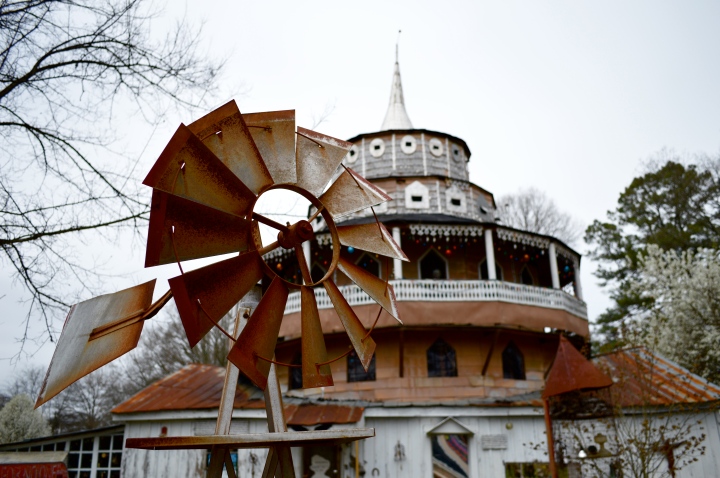 Rusty windmill. In front of the World’s Folk Art Church at Paradise Garden, a rusty windmill turns in the early spring breeze. Like the rest of the objects in the garden, the windmill was made by Howard Finster, from castoff and scrap either found or donated.
Rusty windmill. In front of the World’s Folk Art Church at Paradise Garden, a rusty windmill turns in the early spring breeze. Like the rest of the objects in the garden, the windmill was made by Howard Finster, from castoff and scrap either found or donated.
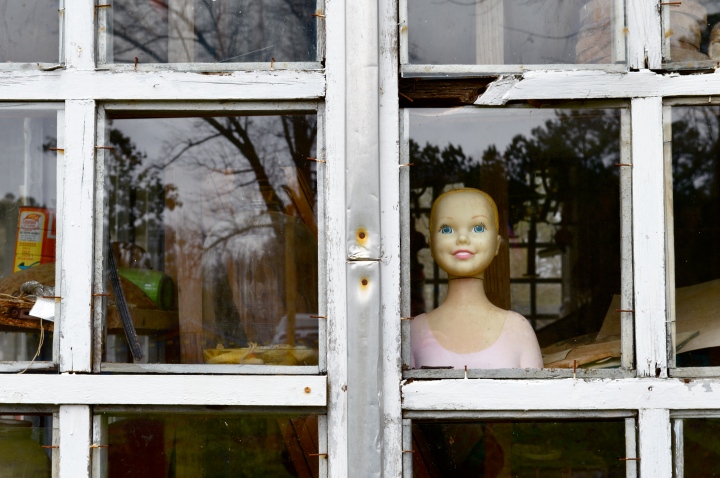 Curios behind glass. A great many odd items can be found around the gardens, not the least of which includes the pickled baby alligators in a jar (left) and the baby doll head (right) pictured behind glass here. I can only speculate as to what things I carelessly bypassed or otherwise simply did not notice on my initial visit, and what might present itself if I went back again.
Curios behind glass. A great many odd items can be found around the gardens, not the least of which includes the pickled baby alligators in a jar (left) and the baby doll head (right) pictured behind glass here. I can only speculate as to what things I carelessly bypassed or otherwise simply did not notice on my initial visit, and what might present itself if I went back again.
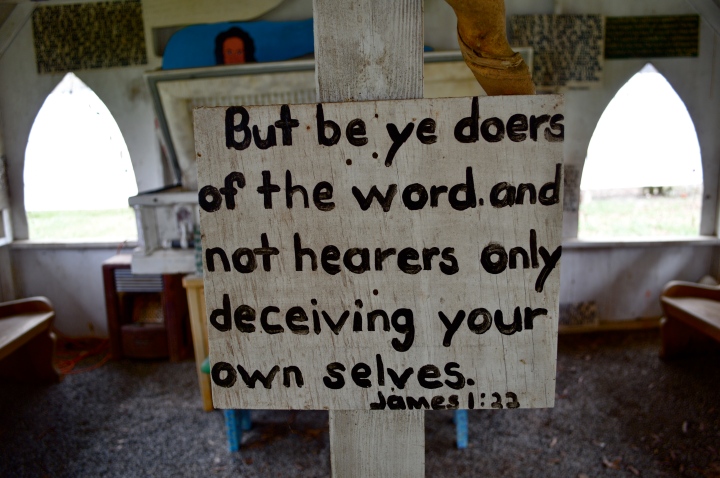 James 1:22. Just one of many Bible verses painted all over Paradise Gardens. It may be true that no one quite knows how many of such verses exist throughout the property. This particular one is located within the Meditation Chapel, and although it is difficult to tell in this photograph, there is an open empty casket in the background.
James 1:22. Just one of many Bible verses painted all over Paradise Gardens. It may be true that no one quite knows how many of such verses exist throughout the property. This particular one is located within the Meditation Chapel, and although it is difficult to tell in this photograph, there is an open empty casket in the background.
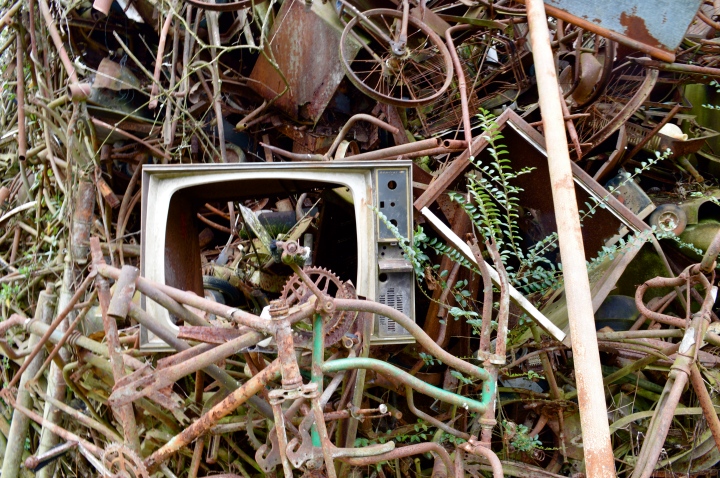 Scrap in the yard. Howard Finster himself described his work best: “I took the pieces you threw away, put them together by night and day, washing in the rain, dried by the sun, a million pieces all in one.”
Scrap in the yard. Howard Finster himself described his work best: “I took the pieces you threw away, put them together by night and day, washing in the rain, dried by the sun, a million pieces all in one.”
As Seen on Examiner.com: “Roadside oddities: Dockery Farms & the birth of the blues”
 My first article for Examiner.com went live this morning. “Roadside oddities: Dockery Farms & the birth of the blues” is the first in a series that I will be publishing regularly on Examiner.com. They will be similar to the travel pieces you’ve seen here on Between the Highway and Home, so don’t be shy about subscribing there, too. You will see the “Subscribe to Author” link at the bottom of each article.
My first article for Examiner.com went live this morning. “Roadside oddities: Dockery Farms & the birth of the blues” is the first in a series that I will be publishing regularly on Examiner.com. They will be similar to the travel pieces you’ve seen here on Between the Highway and Home, so don’t be shy about subscribing there, too. You will see the “Subscribe to Author” link at the bottom of each article.
The Mountains of Tennessee: As Seen on GNN
 It seems awfully quiet and still at first. Then a dog barks down in a farm below and I begin to hear the wind through the pines that sounds like a truck coming around the bend. There is warm sun in the valley and clouds the same dark, blue-grey color as the mountains are moving away over the peaks, giving way to a clear, bright sky. There, above the tree line, there are traces of snow yet harbored by the shadows of the coulees. I can see Mount Le Conte some twenty-four miles distant. This is the austerity of Appalachian winter – the mountainsides bare save for the green of the pines and a crisp chill to the wind. Here, high up on the Foothills Parkway in Blount County, Tennessee, I can see it all.
It seems awfully quiet and still at first. Then a dog barks down in a farm below and I begin to hear the wind through the pines that sounds like a truck coming around the bend. There is warm sun in the valley and clouds the same dark, blue-grey color as the mountains are moving away over the peaks, giving way to a clear, bright sky. There, above the tree line, there are traces of snow yet harbored by the shadows of the coulees. I can see Mount Le Conte some twenty-four miles distant. This is the austerity of Appalachian winter – the mountainsides bare save for the green of the pines and a crisp chill to the wind. Here, high up on the Foothills Parkway in Blount County, Tennessee, I can see it all.
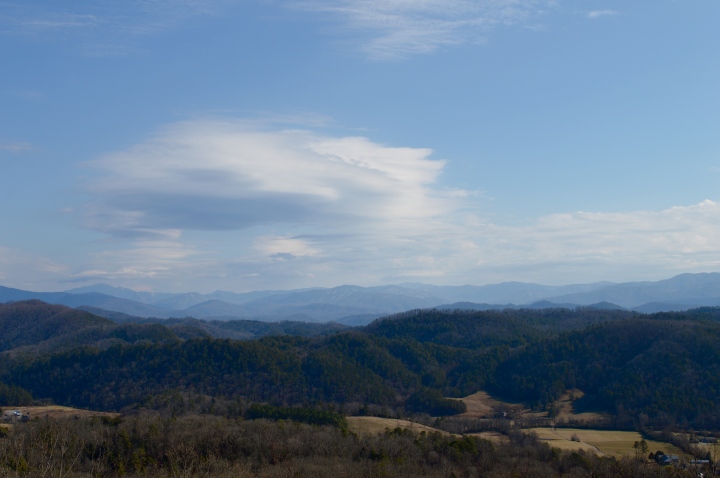 I have been all up and down the spine of the Appalachian Mountains in Tennessee, from the Tri-Cities up in the northeast corner of the state down to Chattanooga down on the Georgia line. Yet of all mountain peaks and valley bottoms, the streams and the small towns, it is here, the Great Smoky Mountains, that I am drawn to like a moth to a light in the night.
I have been all up and down the spine of the Appalachian Mountains in Tennessee, from the Tri-Cities up in the northeast corner of the state down to Chattanooga down on the Georgia line. Yet of all mountain peaks and valley bottoms, the streams and the small towns, it is here, the Great Smoky Mountains, that I am drawn to like a moth to a light in the night.
And I am not alone. The Great Smoky Mountain National Park is the most visited of the nation’s National Parks, and as spring and summer set in, the woods and valleys will thicken with foliage and tourists. So I often make it a point to visit during the winter months, a time when it seems awfully quiet and still at first. But the mountains speak, and if you come prepared to listen, you will hear them.
 This article was originally published on Good News Notebook, 3/13/2015. You can view it on its original format by clicking here, or the banner above.
This article was originally published on Good News Notebook, 3/13/2015. You can view it on its original format by clicking here, or the banner above.
Georgia Byways: the Historic Heartland

On Saturday, Leigh Ann and I made our first foray into Central Georgia – through Butts, Monroe, Bibb, Jones and Balwin counties, a region of orange soil and tall pines where the piedmont slips away into the coastal plain. This vast interior part of Georgia unfolds in a series of long rural routes punctuated by small towns. According to ExploreGeorgia.com, who has divided the state into nine distinct regions, this is called Georgia’s “Historic Heartland.”
I take the byways and the back roads as often as I can. The interstates are, to be sure, the fastest route between two points, but that has never been what Between the Highway and Home is about. I am more interested in what lies in between the two points, where change is slow to come and what there is to find there reflects the way things are in that particular corner of the world. In his book Blue Highways, William Least Heat-Moon wrote: “Life doesn’t happen along interstates. It’s against the law.”
Well, while I see his statement as a somewhat obvious exaggeration, I embrace his sentiment. What can be found right off the interstate is not what makes a place unique, but what makes a place the same as anywhere else. It isn’t until you get off the interstate and onto the byways that you will find Georgia’s pulse. And that’s where I went looking.
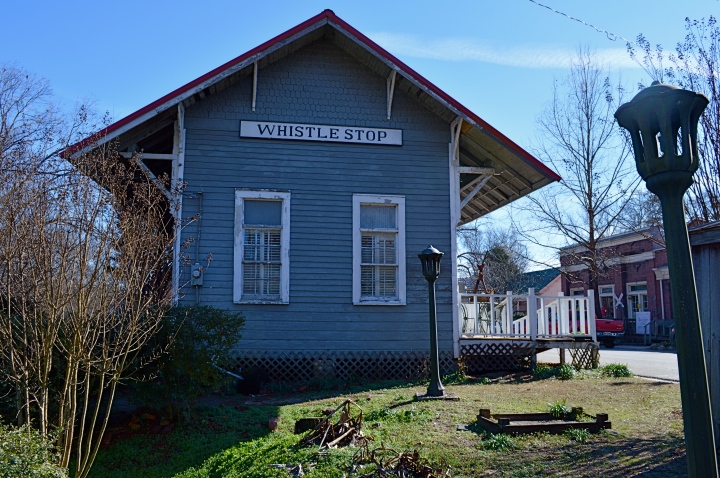 Juliette, Georgia is an out-of-the-way former train stop that might have disappeared into the Georgia wilderness if it hadn’t been the filming location for the Southern cult-classic movie Fried Green Tomatoes. In the movie, Juliette is renamed “Whistle Stop,” and while the train still whistles as it pounds through the town, it has been some time since it stopped there. Above, you can see the defunct train depot turned antique store, which bears homage to the town’s adoptive identity.
Juliette, Georgia is an out-of-the-way former train stop that might have disappeared into the Georgia wilderness if it hadn’t been the filming location for the Southern cult-classic movie Fried Green Tomatoes. In the movie, Juliette is renamed “Whistle Stop,” and while the train still whistles as it pounds through the town, it has been some time since it stopped there. Above, you can see the defunct train depot turned antique store, which bears homage to the town’s adoptive identity.
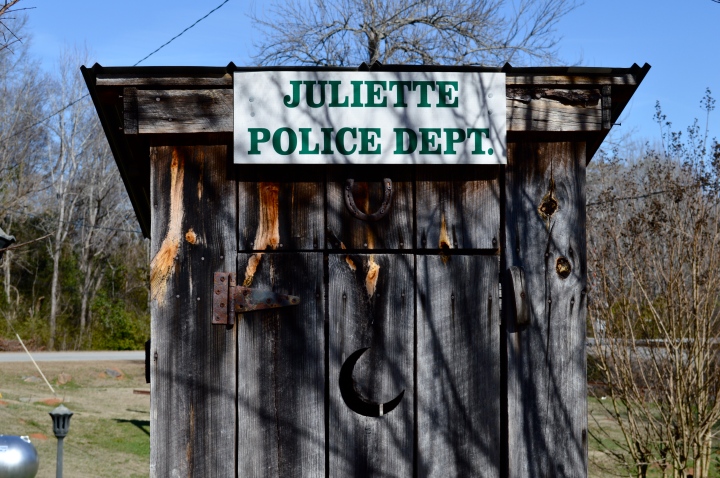 An old wooden outhouse labeled Juliette Police Dept. The town is a mere two-or-three block strip of small shops and eateries, a place that requires little if any policing.
An old wooden outhouse labeled Juliette Police Dept. The town is a mere two-or-three block strip of small shops and eateries, a place that requires little if any policing.
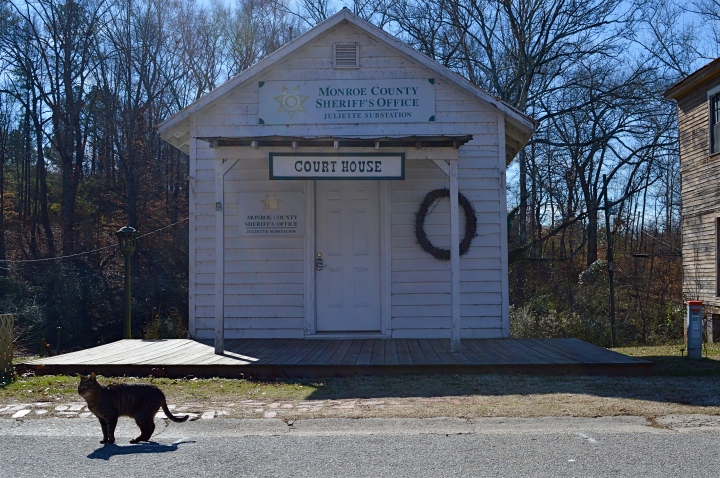 As with the police department, Juliette’s courthouse and sheriff’s office are more quirky than functional. There seem to be as many cats roaming the one-road, no-light town as people.
As with the police department, Juliette’s courthouse and sheriff’s office are more quirky than functional. There seem to be as many cats roaming the one-road, no-light town as people.
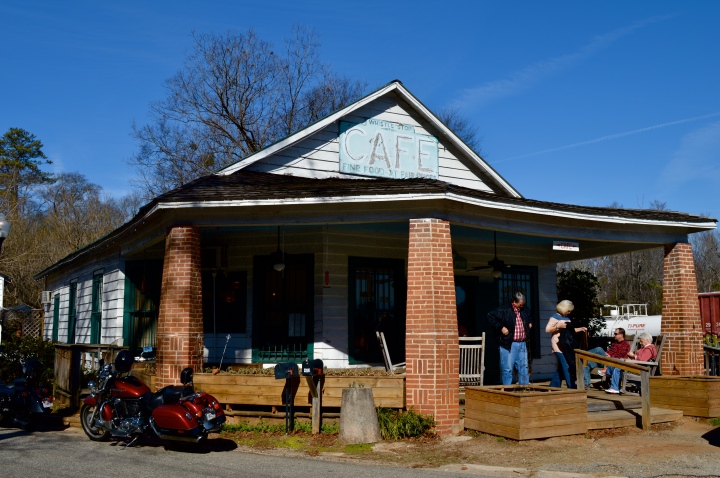 The characters in Fried Green Tomatoes frequent a little restaurant called the Whistle Stop Cafe, which was actually created for the movie and not the other way around. After the movie was released in 1991 and gained popularity, locals opened a real White Stop Cafe, based off the one in the movie. It has been open for business ever since.
The characters in Fried Green Tomatoes frequent a little restaurant called the Whistle Stop Cafe, which was actually created for the movie and not the other way around. After the movie was released in 1991 and gained popularity, locals opened a real White Stop Cafe, based off the one in the movie. It has been open for business ever since.
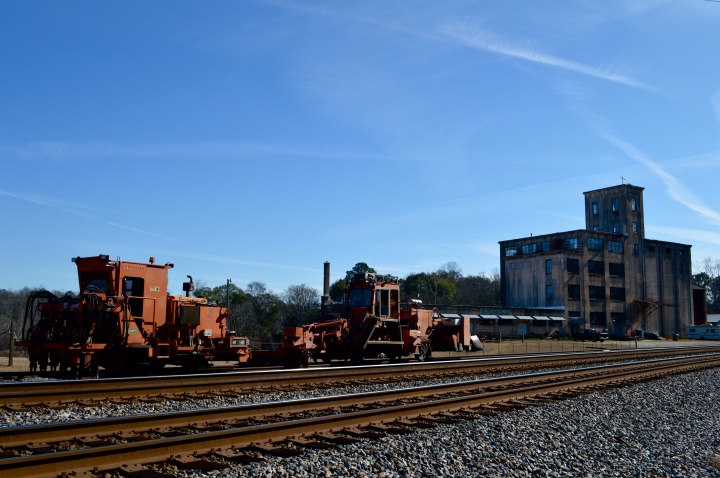 The tracks of the Norfolk Southern railroad in Juliette, with an old abandoned mill or factory behind.
The tracks of the Norfolk Southern railroad in Juliette, with an old abandoned mill or factory behind.
 Heading east out of Juliette, we passed through the Piedmont National Wildlife Refuge. Pictured above is a road through the pines that are perhaps the most characteristic feature of the landscape. We passed few other travelers through this region.
Heading east out of Juliette, we passed through the Piedmont National Wildlife Refuge. Pictured above is a road through the pines that are perhaps the most characteristic feature of the landscape. We passed few other travelers through this region.
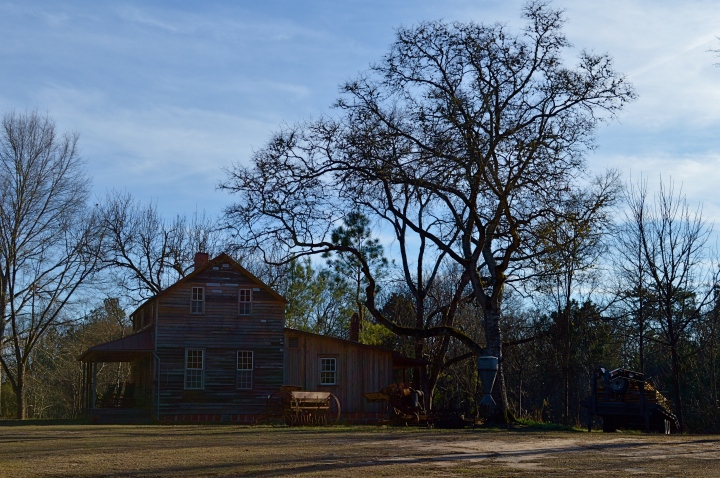 Our final stop that afternoon before heading back home to Decatur was Andalusia Farm in Milledgeville, the home of Southern Gothic novelist and icon Flannery O’Connor. Pictured above is the Hill House, a farmer’s cabin out behind the main house at Andalusia.
Our final stop that afternoon before heading back home to Decatur was Andalusia Farm in Milledgeville, the home of Southern Gothic novelist and icon Flannery O’Connor. Pictured above is the Hill House, a farmer’s cabin out behind the main house at Andalusia.
 Pictured here is a pair of mismatched windows and newspaper insulated walls at the Hill House. Using newspaper was once a common insulation method, back when the logs and boards of homes such as this were hand-hewn and drafty.
Pictured here is a pair of mismatched windows and newspaper insulated walls at the Hill House. Using newspaper was once a common insulation method, back when the logs and boards of homes such as this were hand-hewn and drafty.
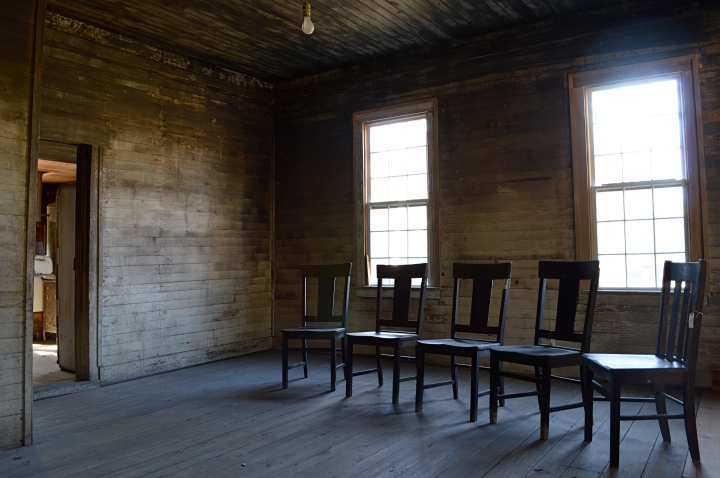 The front room at the Hill House.
The front room at the Hill House.
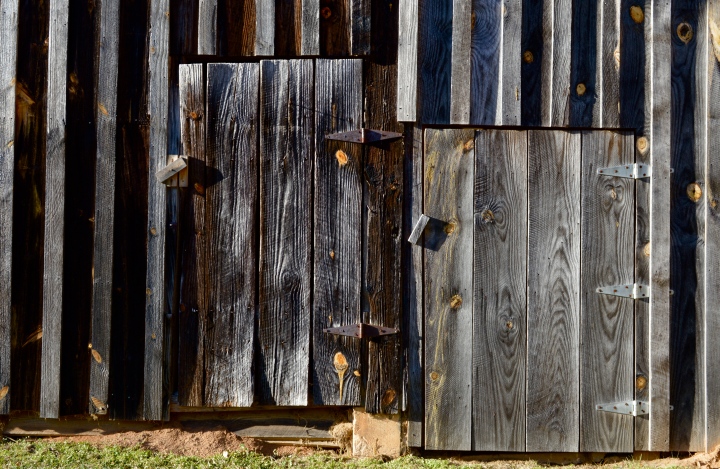 A pair of doors shown from the exterior at the dairy barn at Andalusia.
A pair of doors shown from the exterior at the dairy barn at Andalusia.
 The same doors as pictured above, this time from the interior of the dairy barn.
The same doors as pictured above, this time from the interior of the dairy barn.
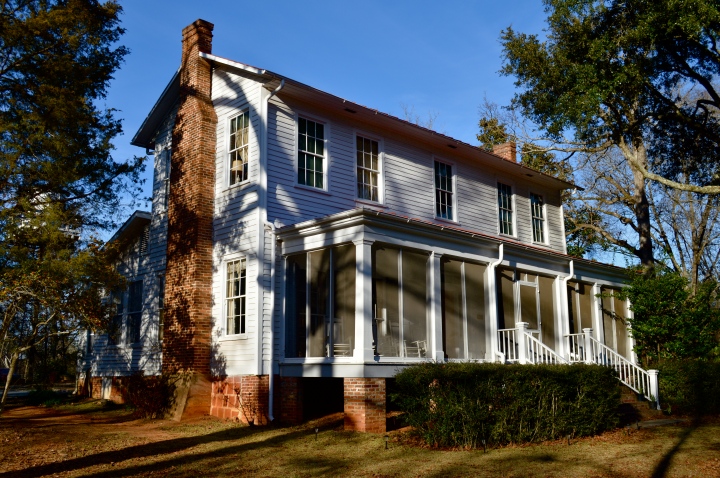 Flannery O’Connor’s residence, the main house, at Andalusia Farm. She wrote most of her work in the front bedroom of his home. It is open to this day for tours. You can find more information at their website.
Flannery O’Connor’s residence, the main house, at Andalusia Farm. She wrote most of her work in the front bedroom of his home. It is open to this day for tours. You can find more information at their website.
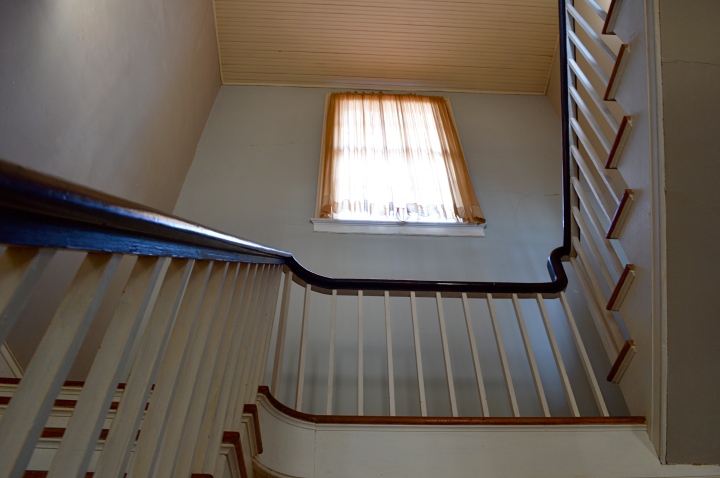 The stairs leading to the second floor inside the home. Although Flannery O’Connor was nearly crippled by lupus and could not use the stairs herself, the family still uses the second floor as private storage. She died in 1964, at the young age of 64, from complication due to lupus.
The stairs leading to the second floor inside the home. Although Flannery O’Connor was nearly crippled by lupus and could not use the stairs herself, the family still uses the second floor as private storage. She died in 1964, at the young age of 64, from complication due to lupus.
A Look Back: Photographs That Didn’t Make the Cut
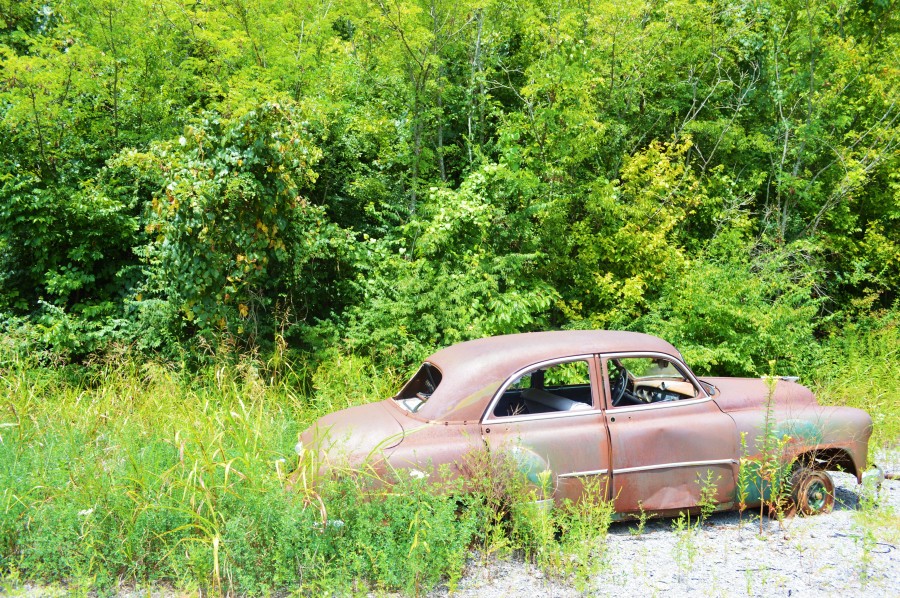
2014 was the year I began documenting the world with a camera. It was also the year that I began this blog. As the year ticked on, I began to realize that I accumulated a lot more shots than I could ever include here. So that’s what this post is about. The photographs included here didn’t make the cut the first time around, perhaps because they went under appreciated or didn’t fit a theme. Maybe they were just too random. Either way, here are my favorite unpublished photographs of 2014.
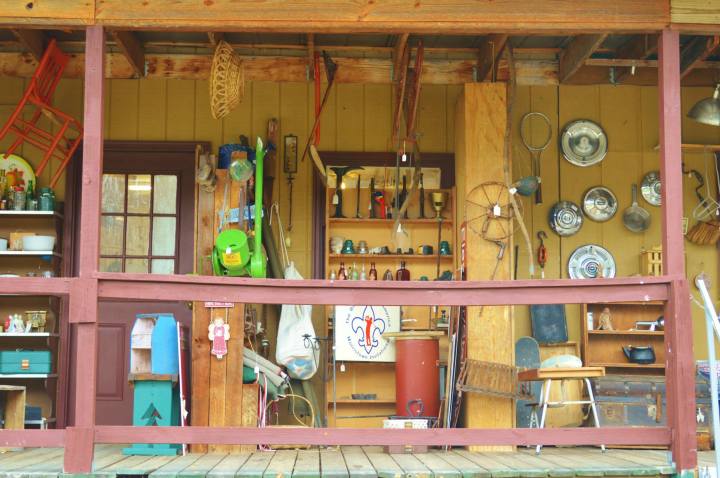 The front porch of an antique shop near Townsend, in Blount County, Tennessee. There are a great many of such shops in the area, with goods ranging from pure junk to rare gems. Often, the hard part is discerning between the two.
The front porch of an antique shop near Townsend, in Blount County, Tennessee. There are a great many of such shops in the area, with goods ranging from pure junk to rare gems. Often, the hard part is discerning between the two.
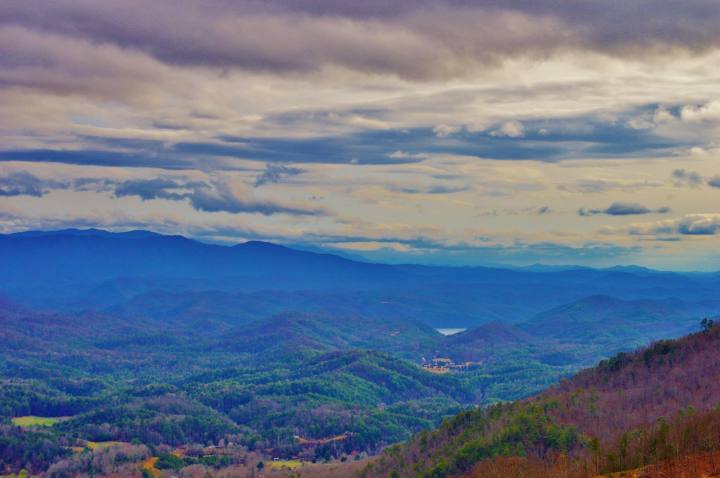 A southwesterly view of the Great Smoky Mountains National Park from the Foothills Parkway in Blount County, Tennessee. A faint sliver of Chilhowee Lake can be seen down in the valley. More of my photographs taken in the Smoky Mountains and East Tennessee can be seen here.
A southwesterly view of the Great Smoky Mountains National Park from the Foothills Parkway in Blount County, Tennessee. A faint sliver of Chilhowee Lake can be seen down in the valley. More of my photographs taken in the Smoky Mountains and East Tennessee can be seen here.
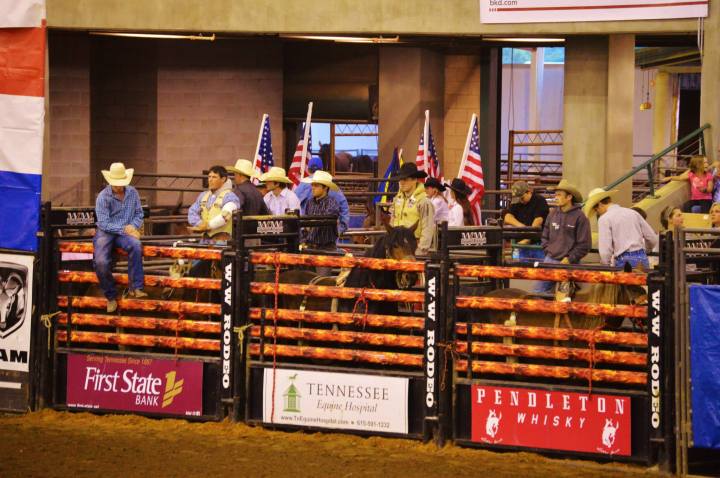 Cowboys on the gates at the Franklin Rodeo. The rodeo comes to Franklin, Tennessee each spring. This was my second year attending.
Cowboys on the gates at the Franklin Rodeo. The rodeo comes to Franklin, Tennessee each spring. This was my second year attending.
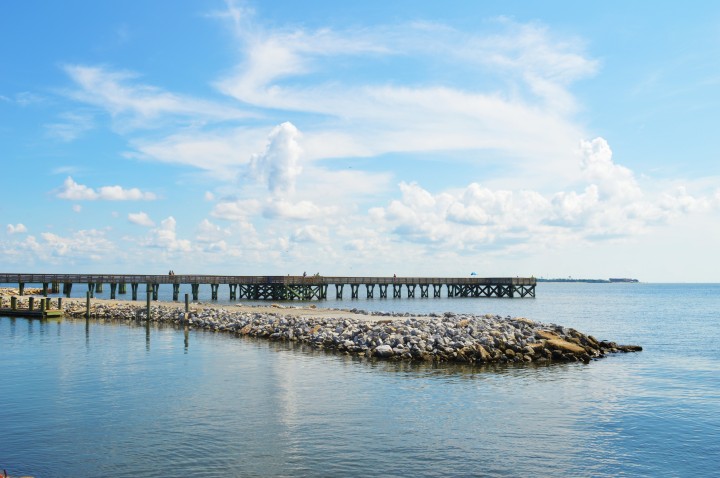 A pier and jetty sticking out into the Gulf of Mexico at Bay St. Louis, Mississippi. Crabbers and fishermen debark from here in the morning, returning later with the day’s catch. This photograph is one of a series, more of which were included in a previous post, which can be visited here.
A pier and jetty sticking out into the Gulf of Mexico at Bay St. Louis, Mississippi. Crabbers and fishermen debark from here in the morning, returning later with the day’s catch. This photograph is one of a series, more of which were included in a previous post, which can be visited here.
 Private boats moored at Pass Christian Harbor on the Mississippi Gulf Coast. The people of the area are indelibly tied to the water, whether for a living or purely for recreation.
Private boats moored at Pass Christian Harbor on the Mississippi Gulf Coast. The people of the area are indelibly tied to the water, whether for a living or purely for recreation.
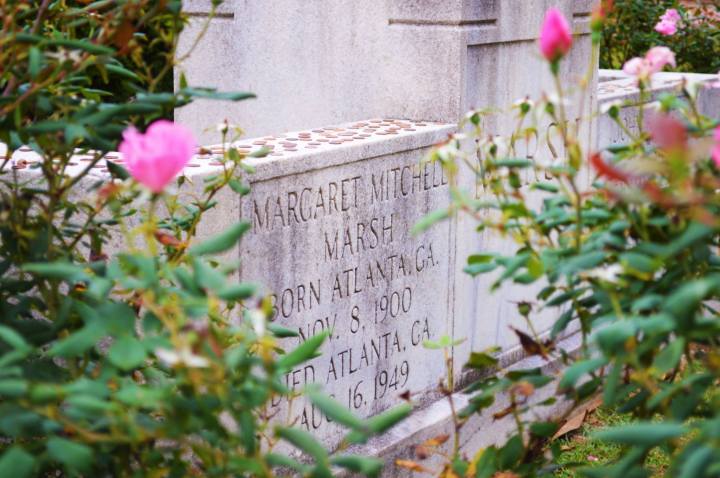 The grave of Margaret Mitchell, author of Gone With the Wind, in Atlanta’s historic Oakland Cemetery. Without a doubt, her novel and the subsequent movie have done more to define the antebellum south for Americans, especially southerners, than facts ever have.
The grave of Margaret Mitchell, author of Gone With the Wind, in Atlanta’s historic Oakland Cemetery. Without a doubt, her novel and the subsequent movie have done more to define the antebellum south for Americans, especially southerners, than facts ever have.
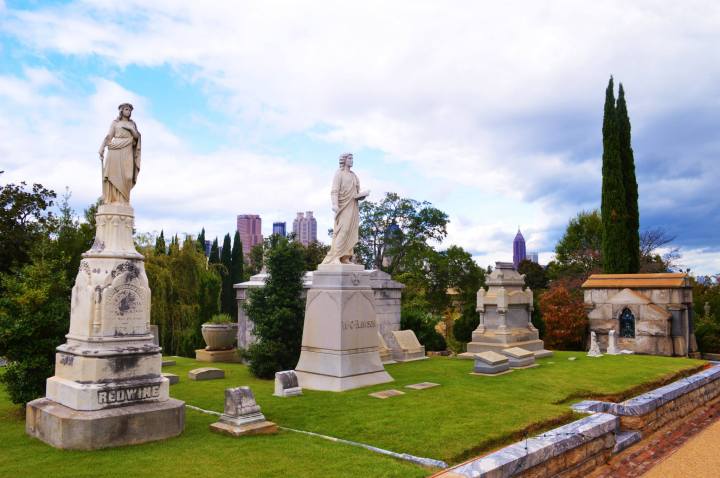 Several other grave sites at Oakland Cemetery with part of the city skyline in the background. The cemetery is sited on a ridge overlooking downtown and interred there are a vast array of people from the famous to the paupers.
Several other grave sites at Oakland Cemetery with part of the city skyline in the background. The cemetery is sited on a ridge overlooking downtown and interred there are a vast array of people from the famous to the paupers.
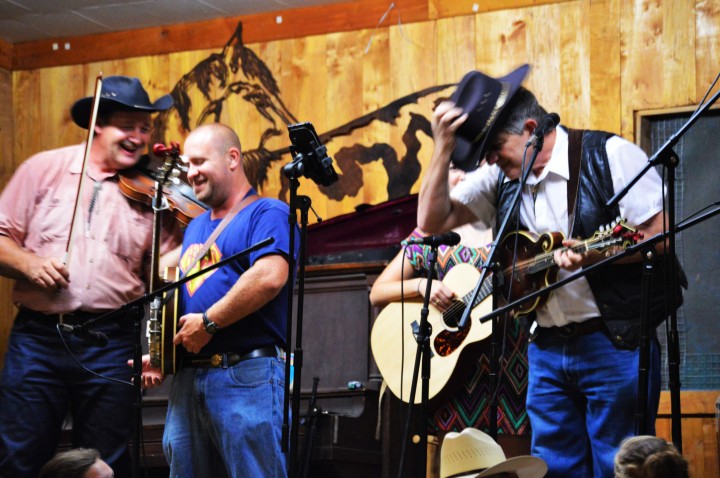 An bluegrass string band thanks the crowd at Sims Opry House in Granite Falls, North Carolina. Another picture from Sims can be seen in an earlier photographic post entitled Southeastern Byways, Part 2, which you can see here.
An bluegrass string band thanks the crowd at Sims Opry House in Granite Falls, North Carolina. Another picture from Sims can be seen in an earlier photographic post entitled Southeastern Byways, Part 2, which you can see here.
 An old car rusts in the sweltering summer humidity of Middle Tennessee. A private collector agreed to let us stroll around his property and take a look at the several hundred vehicles he has collected in his long life.
An old car rusts in the sweltering summer humidity of Middle Tennessee. A private collector agreed to let us stroll around his property and take a look at the several hundred vehicles he has collected in his long life.
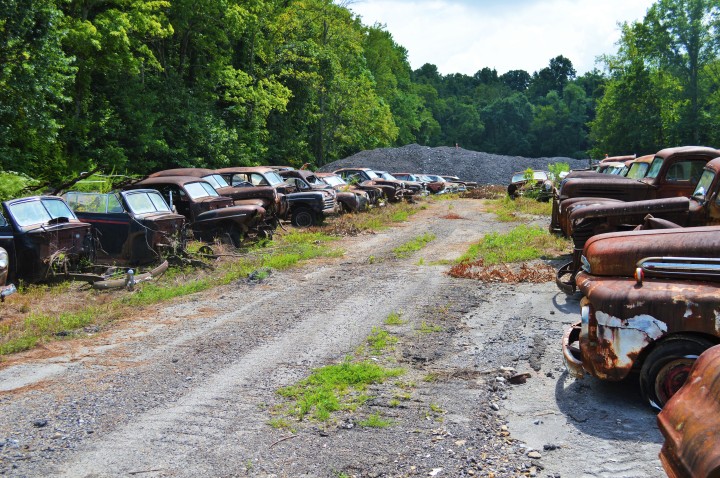 One among many of the long rows of rusting vehicles. It is hard to convey the size and scope of the collection he had. Most of them did not run, but those that did were worth a large fortune and were highly sought after by collectors.
One among many of the long rows of rusting vehicles. It is hard to convey the size and scope of the collection he had. Most of them did not run, but those that did were worth a large fortune and were highly sought after by collectors.
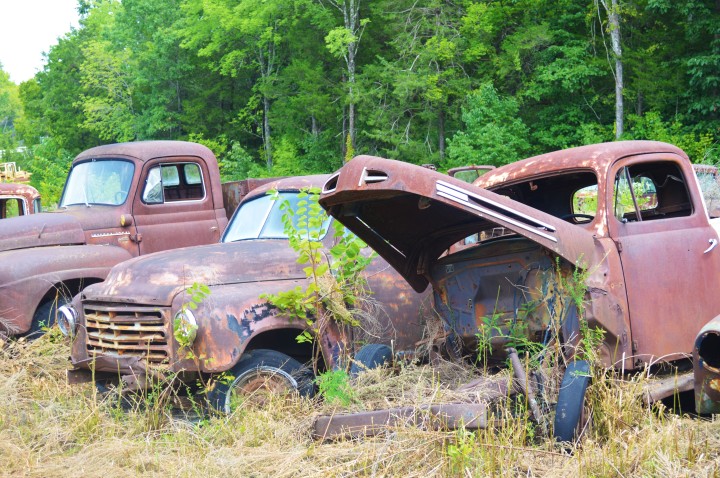 Just three more of the many hundreds of old vehicles that were collected on the lot. The scrap metal on his place alone was worth a considerable amount.
Just three more of the many hundreds of old vehicles that were collected on the lot. The scrap metal on his place alone was worth a considerable amount.
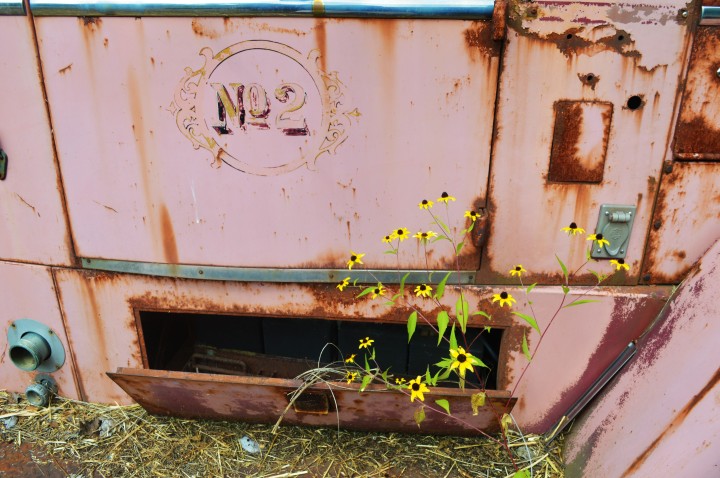 A flower grows up out of the old No. 2 Franklin Fire Department truck that now sits back in the holler, one among many such historic vehicles in the collection.
A flower grows up out of the old No. 2 Franklin Fire Department truck that now sits back in the holler, one among many such historic vehicles in the collection.
 Headstones and bouquets at one of America’s most unique cemeteries: the Key Underwood Coon Dog Memorial Graveyard in rural Colbert County, Alabama. In existence since 1937, there are now over 300 dogs buried here.
Headstones and bouquets at one of America’s most unique cemeteries: the Key Underwood Coon Dog Memorial Graveyard in rural Colbert County, Alabama. In existence since 1937, there are now over 300 dogs buried here.
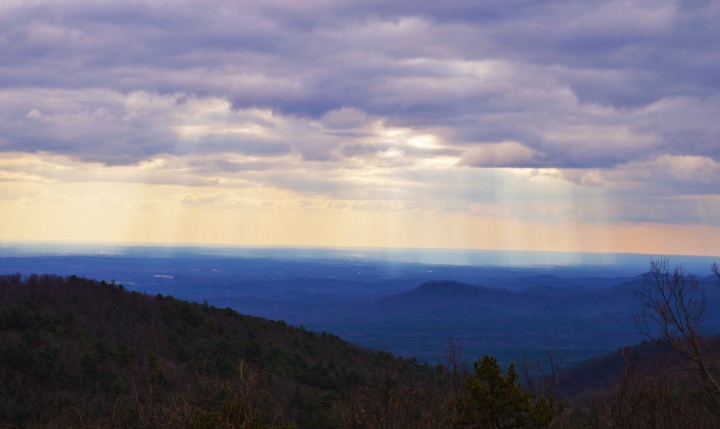 An easterly view of the South Carolina piedmont from high up on US-107 in Oconee County, South Carolina. Most people do not think about the Appalachian Mountains when they think of South Carolina, but none the less, the westernmost portion of the state contains within it part of the Blue Ridge Mountains.
An easterly view of the South Carolina piedmont from high up on US-107 in Oconee County, South Carolina. Most people do not think about the Appalachian Mountains when they think of South Carolina, but none the less, the westernmost portion of the state contains within it part of the Blue Ridge Mountains.
The Old Homeplace: Southern Indiana.

I had not been home to Southern Indiana in a year. The part of Indiana where I was raised bears little resemblance to most people’s conception of what Indiana looks like, the image of flat corn and soybean fields that stretch endlessly into the horizon. It has more in common with Kentucky, in both landscape and culture, than it does with the northern two-thirds of the state. The old homeplace is tucked away in a little valley in northern Lawrence County, not really in any particular town. For years, the dead end road I grew up on wasn’t even named. It just dropped down into the valley and threaded through the woods with a few gravel driveways sprouting off on either side. Ours was one.
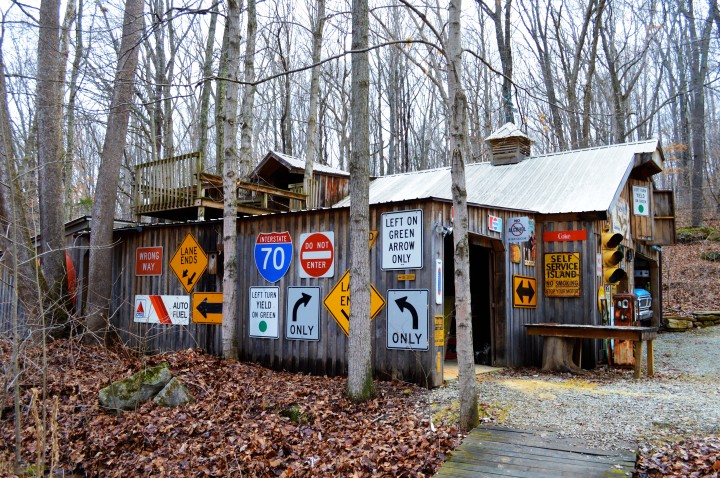 My father’s shed complex has grown over the years into this massive thing across the creeks from the house. Once a series of small structures built from salvaged and reclaimed wood, it has been augmented and added onto so many times that the end result is a building of no discernible design. It has been affectionately named “Tom Town,” after my father, who built it all himself.
My father’s shed complex has grown over the years into this massive thing across the creeks from the house. Once a series of small structures built from salvaged and reclaimed wood, it has been augmented and added onto so many times that the end result is a building of no discernible design. It has been affectionately named “Tom Town,” after my father, who built it all himself.
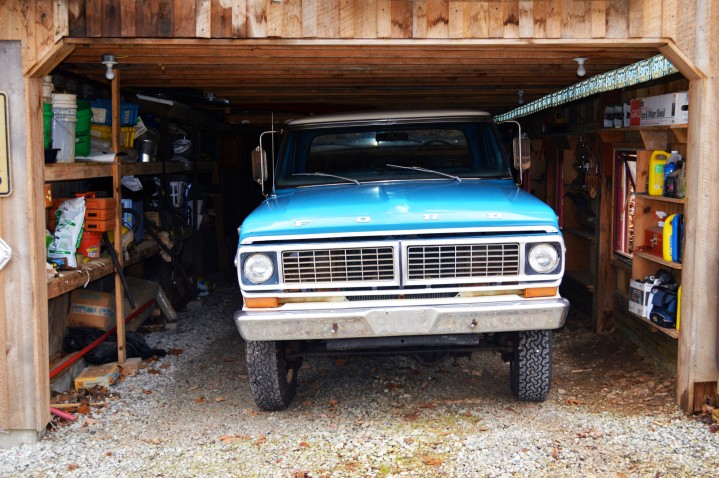 Pictured above is one of the many project trucks on the property. I’m not sure how many such vehicles there are sitting around the place, or how many of them even run.
Pictured above is one of the many project trucks on the property. I’m not sure how many such vehicles there are sitting around the place, or how many of them even run.
 The valley where I grew up was once owned by the Empire Limestone Company, the same company that quarried the rock for the Empire State Building. Pictured above is “chip” limestone, so called because it is not construction grade. It was quarried, graded and then discarded in these massive piles. This is just one of several such piles. Some of the rocks pictured are eight to ten feet across, almost as many feet tall and weigh up to several tons.
The valley where I grew up was once owned by the Empire Limestone Company, the same company that quarried the rock for the Empire State Building. Pictured above is “chip” limestone, so called because it is not construction grade. It was quarried, graded and then discarded in these massive piles. This is just one of several such piles. Some of the rocks pictured are eight to ten feet across, almost as many feet tall and weigh up to several tons.
 The valley is traversed by old roads and even a railroad bed that used to service the limestone enterprise. Pictured above is what remains of one such road, maintained today by one of our neighbors as a four wheeler path.
The valley is traversed by old roads and even a railroad bed that used to service the limestone enterprise. Pictured above is what remains of one such road, maintained today by one of our neighbors as a four wheeler path.
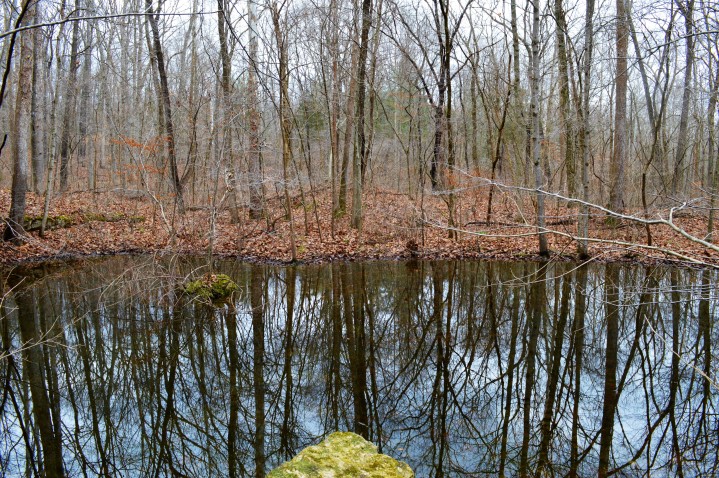 When the stone is removed from the ground, large holes are left behind. These holes quickly fill up with water, creating anything from small ponds, like the one pictured above, to larger tanks like the ones made semi-famous by the movie Breaking Away.
When the stone is removed from the ground, large holes are left behind. These holes quickly fill up with water, creating anything from small ponds, like the one pictured above, to larger tanks like the ones made semi-famous by the movie Breaking Away.
 This portion of Southern Indiana is primarily a hilly woodland. Pictured above is a stand of hickory trees. The entire area is filled with sinkholes that form declivities in the ground, into which soil, leaves, logs, rocks or anything else can completely disappear into underground caverns.
This portion of Southern Indiana is primarily a hilly woodland. Pictured above is a stand of hickory trees. The entire area is filled with sinkholes that form declivities in the ground, into which soil, leaves, logs, rocks or anything else can completely disappear into underground caverns.
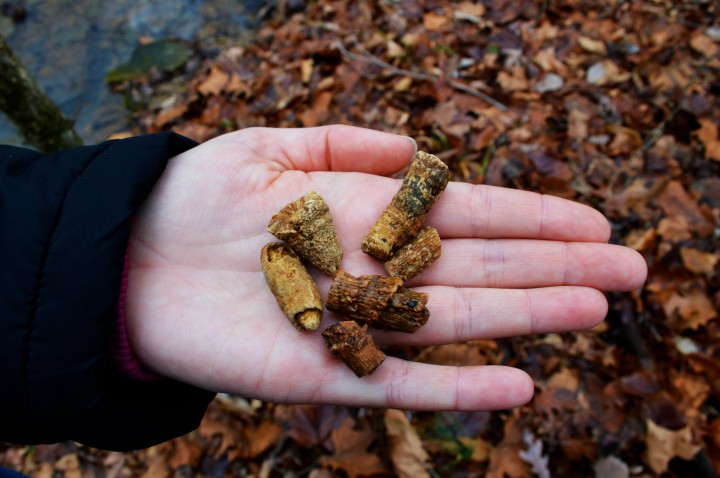 The valley was formed by two creeks that flow together on my parent’s property. The creeks are down to bedrock, exposing countless fossils, crinoids and geodes that can be easily picked from the water. They are so abundant that local gravel is partially made of pulverized fossils.
The valley was formed by two creeks that flow together on my parent’s property. The creeks are down to bedrock, exposing countless fossils, crinoids and geodes that can be easily picked from the water. They are so abundant that local gravel is partially made of pulverized fossils.
 It may come as a surprise that the longest train trestle in the United States is located in Greene County, Indiana. Nearly 2,300 feet across, it is known locally as the Tulip Trestle. Many people in the area aren’t even aware of its existence because it is many miles from any major road and few people go to see it.
It may come as a surprise that the longest train trestle in the United States is located in Greene County, Indiana. Nearly 2,300 feet across, it is known locally as the Tulip Trestle. Many people in the area aren’t even aware of its existence because it is many miles from any major road and few people go to see it.
 Like water towers and overpasses, train trestles are popular places for young locals to drink beer, hook up and vandalize. Pictured above is a small sample of what has over the years become a graffiti mural. There are so many layers of spray paint on the lower reaches of the trestle that the flakes come off in a rainbow of colors.
Like water towers and overpasses, train trestles are popular places for young locals to drink beer, hook up and vandalize. Pictured above is a small sample of what has over the years become a graffiti mural. There are so many layers of spray paint on the lower reaches of the trestle that the flakes come off in a rainbow of colors.
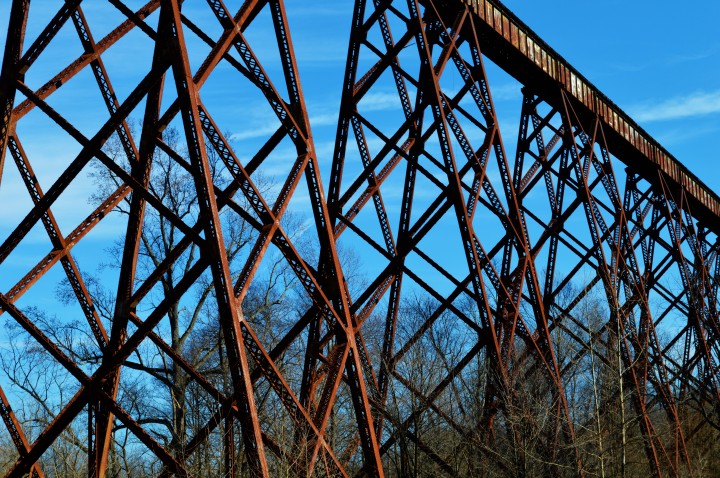 The trestle was completed in 1906 and except for a few small repairs to the structure, it remains exactly as it was when it was completed. The humidity and rain have rusted the towers, but it remains structurally sound and is still in use to this day.
The trestle was completed in 1906 and except for a few small repairs to the structure, it remains exactly as it was when it was completed. The humidity and rain have rusted the towers, but it remains structurally sound and is still in use to this day.
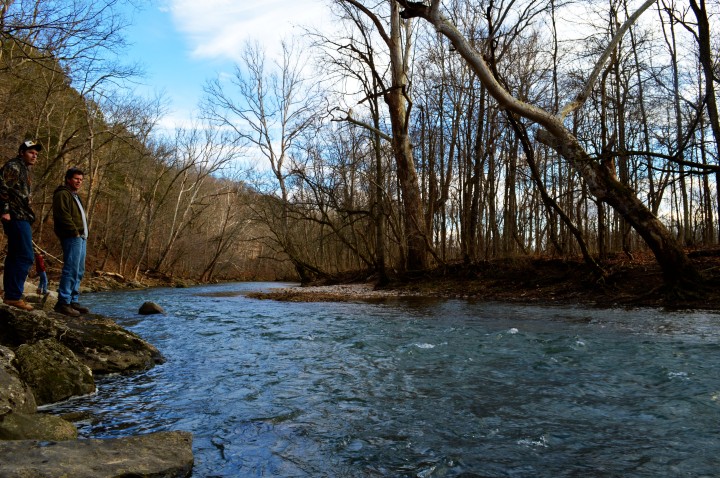 My brother and father standing on the rocky banks of Clear Creek at the Cedar Bluffs Preserve in nearby Monroe County.
My brother and father standing on the rocky banks of Clear Creek at the Cedar Bluffs Preserve in nearby Monroe County.
 An old barn standing against the late-day sun. I often remember the sunsets of my childhood in Southern Indiana.
An old barn standing against the late-day sun. I often remember the sunsets of my childhood in Southern Indiana.
 Just a few years ago, this house was abandoned but still standing. I had moved away by the time the fire happened, burning the house down to the foundation. The limestone porch remains in front.
Just a few years ago, this house was abandoned but still standing. I had moved away by the time the fire happened, burning the house down to the foundation. The limestone porch remains in front.
 Although the state made it illegal several years ago, riding in the bed of a truck is something many small town kids remember fondly. The back roads of Southern Indiana are better seen from the bed than the cab.
Although the state made it illegal several years ago, riding in the bed of a truck is something many small town kids remember fondly. The back roads of Southern Indiana are better seen from the bed than the cab.
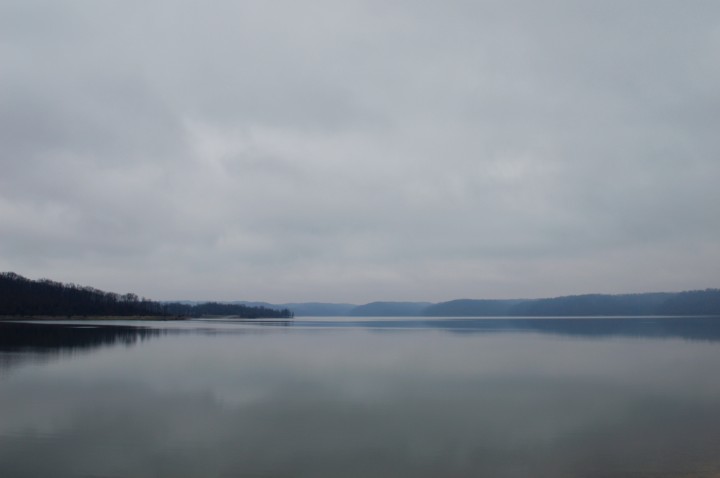 Lake Monroe on a hazy, cloudy day. During the summer, the lake will be filled with anything from fishing skiffs to pontoons. At night, bonfires will burn on the shores. But on a cold December day, the place is empty and silent.
Lake Monroe on a hazy, cloudy day. During the summer, the lake will be filled with anything from fishing skiffs to pontoons. At night, bonfires will burn on the shores. But on a cold December day, the place is empty and silent.
 When I was a child, this was one of those in-between places not serviced by interstates or navigable rivers. It was a place rarely visited. There was always talk of I-69 coming through, and this year was the first year that I could actually use it. It is still incomplete through Greene and Monroe counties, but the end of the project is in sight.
When I was a child, this was one of those in-between places not serviced by interstates or navigable rivers. It was a place rarely visited. There was always talk of I-69 coming through, and this year was the first year that I could actually use it. It is still incomplete through Greene and Monroe counties, but the end of the project is in sight. 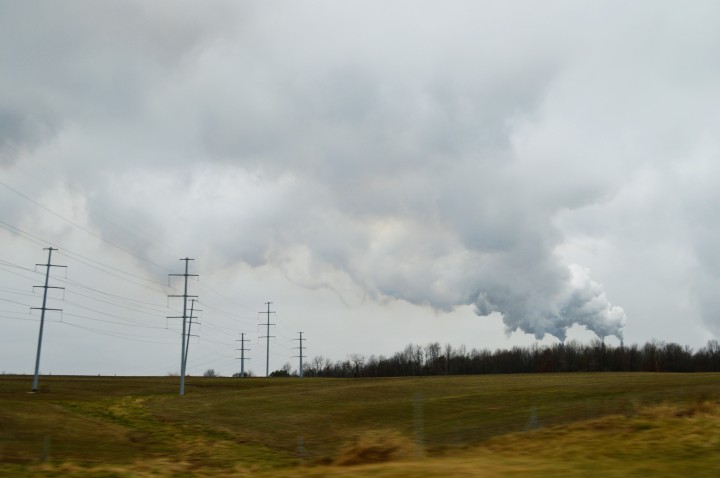 Off of I-69 there are several large power plants. On a cloudy day, what comes bellowing out of the smoke stacks melds with the clouds such that they are hardly discernible (Photo credit: Leigh Ann Graham)
Off of I-69 there are several large power plants. On a cloudy day, what comes bellowing out of the smoke stacks melds with the clouds such that they are hardly discernible (Photo credit: Leigh Ann Graham)
 It is not far into the flatlands on I-69 that a more typical image of Southern Indiana can be seen. This is what much of the Midwest looks like.
It is not far into the flatlands on I-69 that a more typical image of Southern Indiana can be seen. This is what much of the Midwest looks like.
Southeastern Byways: the Carolina Piedmont

I wish to give a special thanks to Patricia Graham and her late husband John “Bud” Graham, in whose memory the following photographs are dedicated.
~
These scenes were photographed on the piedmont byways that lie between Charlotte, North Carolina and Spartanburg, South Carolina. Perhaps to some viewers, they may appear austere or somber. The overcast, late December days on which they were taken certainly add to this tone, as do the subjects I have chosen to shoot. Admittedly, these scenes are not glamorous. I have chosen to focus my lens largely on the grittier aspects of life in this region. Yet what does not appear in these shots is the brand new fire department in Cowpens, South Carolina or the revitalized downtown of Belmont, North Carolina. And what cannot appear in these shots is the manner and spirit of those who live in these places. In all the world, you may find people and communities that compare to, but cannot be held above, the kindness, hospitality, dignity and grace of those who reside in the Carolina Piedmont.
~
A depiction of Christ (Belmont, NC)
Dixie Marine & Automotive (Gaston County, NC)
John “Bud” Graham’s macaws (Gaston County, NC)
A garage on the Graham farm.
A donkey on the Graham farm.
Marble Christ at Gaston Memorial Park (Gaston County, NC)
Christmastown, USA (McAdenville, NC)
Crowds gathering in McAdenville.
Antique store in Gaston County, NC.
1 John 5 (near Blacksburg, SC)
Vacant car lot near Blacksburg, SC.
Crossroads outside of Gaffney, SC.
Was a Piggly Wiggly in Cowpens, SC.
The Road to Medicine Stone.

In September, my girlfriend and I left Atlanta on a road trip that would take us over 2,500 miles in ten days, ending at a three day country music festival called Medicine Stone in Tahlequah, Oklahoma. The route took us through Georgia and Alabama to Bay St. Louis, Mississippi, (which you can read about in my last post, here) then on through Louisiana to Austin and then Fort Worth, Texas, and lastly to Oklahoma for the festival. When the music was over, we drove back in one day via Arkansas, Tennessee, Mississippi, Alabama and finally back to Atlanta, Georgia. I took all the photographs that follow along the way.
A mural painted on the back of a shed at an elementary school in Saucier, MS that encompasses every state on our road trip.
Fishing and crabbing boats moored at the docks in Pass Christian, Mississippi.
The Tomb of the Unknown Confederate Soldier at Beauvoir, the last home of Confederate President Jefferson Davis, in Biloxi, MS.
New growth in the Blue Elbow Swamp in the Tony Housman State Park in Orange County, Texas.
A boardwalk winding through the Blue Elbow Swamp.
Road sign on the side of I-10 at the Louisiana/Texas state line. Texas ain’t so big after all.
Sunset on US-290 in Elgin, Texas, just south of Austin.
Confederate Monument on the lawn of the State Capitol Building in Austin, Texas.
Tile saints at the Saint Elias Orthodox Christian Church in downtown Austin.
Skyline of Austin as seen from Mount Bonnell just before sunset.
Sunset over the Colorado River as seen from Mount Bonnell.
The famous bats that fly out from under the South Congress Bridge in downtown Austin around sunset.
Longhorns and the cowboys that drive them every day in the Fort Worth Historic Stockyards.
A window in a store in the Fort Worth Stockyards.
A Cherokee tour guide in a Cherokee council wigwam at the Cherokee Heritage Center in Park Hill, Oklahoma.
Jason Eady performing on Friday afternoon at Medicine Stone in Tahlequah, Oklahoma.
Jason Boland & the Stragglers performing on Saturday night at Medicine Stone.
Sunrise over the Cherokee Nation the Sunday morning we left Oklahoma for Georgia.
